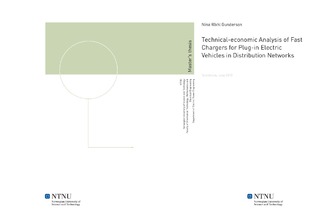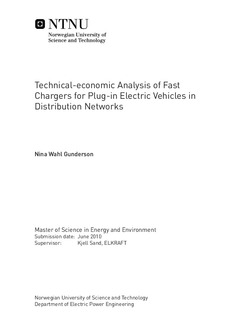| dc.contributor.advisor | Sand, Kjell | nb_NO |
| dc.contributor.author | Gunderson, Nina Wahl | nb_NO |
| dc.date.accessioned | 2014-12-19T13:52:20Z | |
| dc.date.available | 2014-12-19T13:52:20Z | |
| dc.date.created | 2010-10-26 | nb_NO |
| dc.date.issued | 2010 | nb_NO |
| dc.identifier | 359158 | nb_NO |
| dc.identifier | ntnudaim:5645 | nb_NO |
| dc.identifier.uri | http://hdl.handle.net/11250/256929 | |
| dc.description.abstract | The project is focusing on on finding the optimal grid connection of fast charging stations for electric vehicles. The project was carried out in cooperation with Lyse, which is the regional utility company in Rogaland, Norway. Lyse is developing combined filling stations for gas vehicles and fast chargers for electric vehicles. The first combined station will be built close to an existing petrol station in Luravika, Sandnes. There is space for four fast chargers at the site. The closest distribution substation is located about 200m up the street. There are both a gas pipe and a 22kV cable close to the site. The area is in an urban environment and the distribution grid consists of underground cables and pipes. Different load cases were studied using Powel Netbas for load flow simulations and a simulation tool called Dynko for economic analysis. Each load case included a certain power rating on the EV charging station. To achieve short charging times, the power rating should be high. Power ratings spanning from 125kW to 500kW were analysed for the charging station. Two solutions for grid connection were evaluated. One involved using the existing distribution substation. The other involved installing a new substation close to the new load. The optimal dimensioning of cables and transformers were analysed. The quality of supply and fulfilment of the Norwegian PQ code were evaluated.The economic results showed that it is optimal to use the existing distribution substation as long as the total maximum load at the combined filling and charging station is less than 263kVA. For larger loads, a new substation should be built close to the new load. Replacing the transformer in the existing substation is not an optimal solution for any of the load cases. The cables should be chosen so that the loading is close to 30%. The average optimal transformer loading was around 75%, but the results had a large variance. The quality of supply was investigated for the worst case scenario. All values concerning voltage variations and harmonics were well within the limits of the Norwegian PQ code. The loading of the high voltage distribution grid was considered acceptable. No adjustments are needed in the 22kV grid. | nb_NO |
| dc.language | eng | nb_NO |
| dc.publisher | Institutt for elkraftteknikk | nb_NO |
| dc.subject | ntnudaim:5645 | no_NO |
| dc.subject | SIE5 energi og miljø | no_NO |
| dc.subject | Elektrisk energiteknikk | no_NO |
| dc.title | Technical-economic Analysis of Fast Chargers for Plug-in Electric Vehicles in Distribution Networks | nb_NO |
| dc.type | Master thesis | nb_NO |
| dc.source.pagenumber | 73 | nb_NO |
| dc.contributor.department | Norges teknisk-naturvitenskapelige universitet, Fakultet for informasjonsteknologi, matematikk og elektroteknikk, Institutt for elkraftteknikk | nb_NO |

